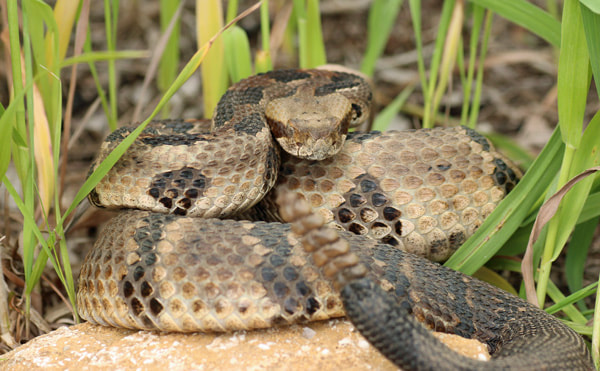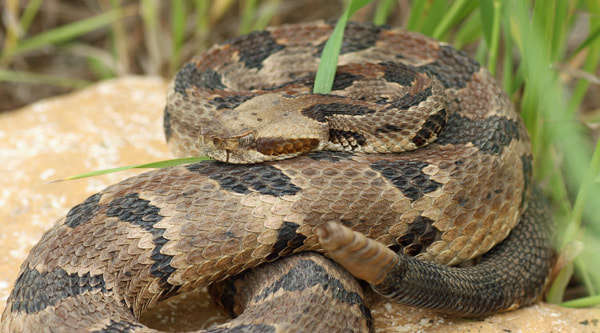TIMBER RATTLESNAKE
Crotalus horridus
Venomous
The Timber Rattlesnake is Missouri's largest venomous snake due to its long fangs, impressive size, and high venom yield. Formerly found statewide, but now eliminated from many counties. Before striking, they often perform a good deal of preliminary rattling and feinting.
The snake's dorsal is tan or yellowish tan and has markings along the back that are dark brown to black blotchy crossbands, these change from blotches on the neck and back to bands or all black near the tail. A black line extends from the eye along the angle of the jaw, and there is a rust-colored stripe down the back. There is a large rattle at the end of its ta The underside is yellowish, uniform or marked with black. Some individuals are very dark, almost solid black.
Adults sizes range from 36 to 60 inches (about 3–5 feet) and can weigh up to 4.5 pounds.
Their prey are mainly small mammals, but may include small birds, frogs, small rabbits, including other snakes. They use their venom so that they can take their prey without a struggle. These rattlesnakes live in rocky, wooded hillsides and mature forests.
The Timber Rattlesnake is Missouri's largest venomous snake due to its long fangs, impressive size, and high venom yield. Formerly found statewide, but now eliminated from many counties. Before striking, they often perform a good deal of preliminary rattling and feinting.
The snake's dorsal is tan or yellowish tan and has markings along the back that are dark brown to black blotchy crossbands, these change from blotches on the neck and back to bands or all black near the tail. A black line extends from the eye along the angle of the jaw, and there is a rust-colored stripe down the back. There is a large rattle at the end of its ta The underside is yellowish, uniform or marked with black. Some individuals are very dark, almost solid black.
Adults sizes range from 36 to 60 inches (about 3–5 feet) and can weigh up to 4.5 pounds.
Their prey are mainly small mammals, but may include small birds, frogs, small rabbits, including other snakes. They use their venom so that they can take their prey without a struggle. These rattlesnakes live in rocky, wooded hillsides and mature forests.






